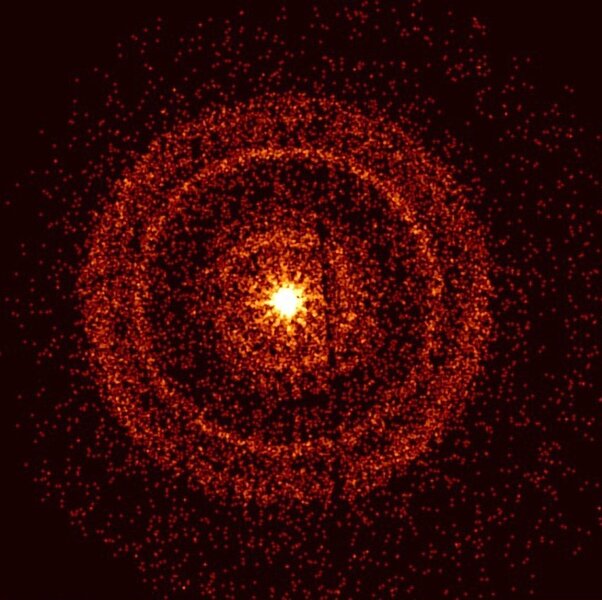Create a free profile to get unlimited access to exclusive videos, sweepstakes, and more!
What Is Powering the Largest Explosion Since the Big Bang?
Astronomers are trying to find out.
In the Farscape pilot (streaming now on Peacock), the astronaut John Crichton (Ben Browder) straps into the experimental spacecraft Farscape-1 for a quick slingshot around the planet. What he didn’t count on was running face first into a wormhole to a distant part of the galaxy. During his travels, Crichton encounters all manner of weird and incredible things that no other human will ever see. But no matter how far he travels, he’ll never encounter an explosion bigger than this.
On October 9, 2022, astronomers observed a gamma ray burst (GRB) coming from the constellation Sagitta, roughly 2.4 billion light-years from here. The explosion, dubbed GRB 221009A, is so far the most powerful explosion astronomers have ever uncovered, save for the Big Bang itself. Now, new research is uncovering what fuels the biggest explosion of all time.
What Happens When Stars Die
For our own Sun, the end will begin in about a billion years, at least from our perspective. By that point, the Sun’s luminosity will be about 10% higher, pushing surface temperatures ever higher. According to some climate models, liquid water will completely evaporate from the surface of the Earth in about a billion years.
RELATED: A Dying Star Produced the Most Powerful Cosmic Blast We’ve Ever Seen
Roughly five billion years after that, the Sun will reach the end stages of its lifespan. The Sun is mostly made of hydrogen, but deep inside its core, that hydrogen fuses into helium, releasing tremendous amounts of energy which eventually make their way to the surface of the Sun and out into space. That’s how you can get a tan on a nice summer day; that’s the leftover energy from the fusion of hydrogen 93 million miles from here.
Several billion years from now, the Sun will run out of hydrogen to fuse in the core, as a result, the core will shrink and heat up enough to start fusing hydrogen again in a thin shell around the core. As that hydrogen fuses, more helium drops into the core and the process repeats. Eventually, the Sun won’t be able to fuse hydrogen anymore and it will move on to helium, then carbon, and oxygen. With each step in the process, the outer shell of the Sun swells (it contracts sometimes too, but that’s less important for our purposes), pushing the Sun into its red giant phase. When that happens, Mercury and Venus will be consumed, no question about it. The Earth might get swallowed too, but even if it doesn’t, it’ll be melted to planetary slag. Eventually, the Sun will work through all of its materials, shed its outer layers, and end its life as a white dwarf.
That’s all bad enough, but when stars much larger than the Sun die, things can get seriously catastrophic. If a star is large enough, the struggle between gravity pushing inward and fusion pressure pushing outward continues considerably longer. Eventually, the battle is lost all at once and the star collapses violently.
The truly massive stars collapse in on themselves and form a black hole; stars a little less massive erupt in violent explosions called supernovae. When either of those events happen, incredible amounts of gamma radiation are released in what scientists call a gamma ray burst (GRB).
The Brightest GRB of All Time
GRBs are unequivocally the most powerful explosions astronomers observe in the universe. Each one is capable of releasing, in just a few seconds, as much energy as the Sun will unleash in its entire existence. But the GRB detected in October 2022 makes other GRBs look like night lights. The energy released from GRB 221009A was so bright that scientists have dubbed it the BOAT, short for Brightest Of All Time, and they’ve spent the better part of a year trying to understand what makes it stand out from the cosmic crowd. Not only was its initial burst unusually bright, but GRB 221009A also exhibited a long afterglow, which persisted for months.
RELATED: So, Um, Maybe the Sun *Will* Eventually Swallow the Earth. Bummer.
The new study, published in the journal Science Advances, describes an atypical structure to the jet of material streaming out from the site of the explosion. Poring over astronomical data from the October event, researchers noticed the GRB’s beam had a narrow core with wide sloping wings. That’s not the sort of thing they’ve seen before, and it could explain why this GRB was so powerful.
"For a long time, we have thought about jets as being shaped like ice cream cones. However, some gamma-ray bursts in recent years, and in particular the work presented here, show that we need more complex models and detailed computer simulations of gamma-ray burst jets," said Alexander van der Horst, associate professor of physics at GW and study co-author, in a statement.
Astronomers suggest that the unusual shape of the wings around the beam might have dragged a large amount of stellar material along with it, contributing to the intensity of the burst as well as its extended lifespan.
There’s lots of cool stuff to see in the universe, and you can see plenty of it on Farscape, streaming now on Peacock!
































